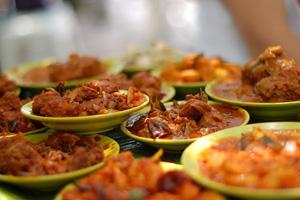
Seasoning blends christened as "curry" include many varieties, which reflect distinct ethnic culinary regions and individual cooks from a wide range of culturally diverse areas across the globe. However, curry is about more than a pre-made or freshly ground powder with multiple ingredients. The word actually is a derivative of an Indian word, kari, meaning sauce, which originally referred to hot and spicy, gravy-based dishes from eastern India.
Used as a spice blend, curry may contain up to 20 ingredients including cardamom, chiles, cinnamon, cloves, coriander, cumin, fenugreek, mace, nutmeg, red and/or black pepper, poppy/sesame seeds, saffron, tamarind, and turmeric.
One of the earliest formal British curry recipes appeared in 1747 in The Art of Cookery made Plain and Easy by Hannah Glasse. By 1953, curry had become so popular in Great Britain that they created 'Coronation Chicken' to commemorate Queen Elizabeth II's coronation. The dish features chicken, curry cream sauce and dressing with ginger, star anise, garlic, peppercorns, leek, lemon, and orange flavors.
"Coronation Chicken probably started from our Indian population, and we suited it to our own tastes so it's not quite as hot," says Suzanne Thomas, customer service manager for British Delights in Westford, Mass. "It's a cross between Indian and Jamaican curries. Kormas with coconut milk are one of the most popular curry dishes, such as Chicken Tikka, which is Indian but we've made a varied recipe."
In Jamaica, highly popular curried goat combines goat meat with scallions, curry powder, onions, garlic, scotch bonnet peppers, and thyme, served with plain boiled rice. South African Cape Malay curry combines beef stew meat with turmeric, cumin, coriander, chili powder, cinnamon, ginger, bay leaves, garlic, bell pepper, dried apricot, red wine vinegar and low-fat buttermilk.
Curries, often described by color, range from yellow to red or green, says Sue Sawatdee, owner of seven Sawatdee restaurants in the Minneapolis area that serve Thai food. Thai cuisine includes dozens of curry dishes with different textures and heats, which they typically serve with white or jasmine rice.
"Thai curry uses the heavy curry spice from India, blended with coconut milk, meat, and vegetables," Sawatdee says. "We make the curry paste first and it's a little sweet, salty, sour, and hot. The more you simmer curry the more delicious [it becomes]."
Filipino Kare Kare combines beef or cleaned beef tripe, oxtail, peanut butter, anchovies, onions, garlic, eggplant, ground toasted rice, bok choy, and string beans with curry. The popular German fast food, currywurst, mixes kielbasa with a sauce made from tomato and chili sauce, onion salt, sugar, black pepper, paprika and curry powder to taste.
Curry is also an important ingredient in Pakistani cuisine. Curry eggs over rice, a Pakistani dish, features coriander, cumin, chili powder, turmeric, cider vinegar, onion, ginger, garlic, tomatoes, with hard-boiled eggs and a cilantro garnish. Pakistani Chicken Curry is also very popular in the country, says Syed Azfer Iqbal, program management specialist of the U.S. Embassy in Islamabad, Pakistan.
"It is a very traditional recipe originated from India and people usually have it for special occasions. It is also very common if you have guests, during wedding ceremonies and other festivities, or even for funerals when you have out of town guests at home for condolence," he says. "People prefer [Pakistani Chicken Curry] with both bread and rice. You can also serve it with green salad, yogurt paste (Raita), or pickle. Kids love it with tomato ketchup, garlic ketchup, or mayonnaise salad dressing."
Whether it is yellow, red, or green, curry powder and sauce adds complex flavors to any dish, from Jamaica to England and beyond.
To learn more see the following books:
660 Curries by Raghavan Iyer, Workman Publishing Company, Inc., April 2008
Curry: A Tale of Cooks and Conquerors by Lizzle Collingham, Oxford University Press, April 2007
Curry Cuisine by Corinne Trang, David Thompson, Das Sreedharan, DK Publishing, Inc., October 2006
Pakistani Chicken Curry or Chicken 'KARAHEE'
Recipe provided by Syed Azfer Iqbal
Makes 6-7 servings
2 kg (approximately 3 ½-4 pounds) chicken
2-3 regular onions, chopped
1 kg (approximately ½ pound) tomato, minced
Salt, to taste
Red chili, to taste
¼ teaspoon powdered turmeric
1 ½ tablespoons garlic paste
15-20 thin slices of one-inch ginger
8-10 green chiles, chopped
Cilantro leaves, as you like
Additional ginger slices
Take the chicken pieces and marinate in the garlic paste.
In Dutch oven or large skillet, heat oil over medium-high heat for 1 minute. Add onion and red chili to the pan and cook, stirring occasionally, for about 7 minutes or until onion begins to brown.
Add ginger and cook, stirring, for another 1-2 minutes, until ginger browns.
Add minced tomato, turmeric, and salt, and stir well for 1-2 minutes. Mixture will be thick; add 2-3 tablespoons water to make it easier to stir.
Then add the marinated chicken pieces in pan and cook, stirring occasionally, for two minutes. Add ½ cup water, stir well, and cover pan. Turn heat to low and simmer curry 8 minutes. Taste sauce for salt and add more if necessary. Serve sprinkled with chopped green chili, ginger and cilantro leaves if you like.
